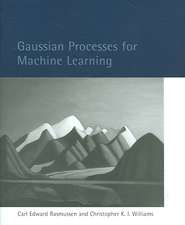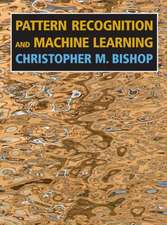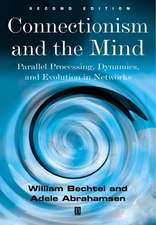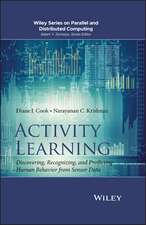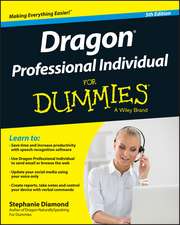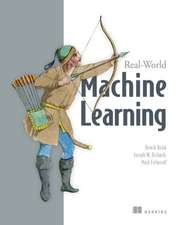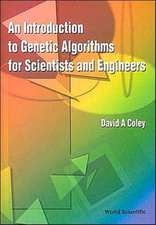Industrial Applications of Neural Networks: Project ANNIE Handbook: Research Reports Esprit, cartea 1
Editat de Ian F. Croall, John P. Masonen Limba Engleză Paperback – 10 noi 1992
Din seria Research Reports Esprit
- 20%
 Preț: 332.71 lei
Preț: 332.71 lei - 20%
 Preț: 644.81 lei
Preț: 644.81 lei - 20%
 Preț: 334.20 lei
Preț: 334.20 lei -
 Preț: 382.36 lei
Preț: 382.36 lei - 20%
 Preț: 478.74 lei
Preț: 478.74 lei - 20%
 Preț: 647.28 lei
Preț: 647.28 lei - 20%
 Preț: 640.69 lei
Preț: 640.69 lei - 20%
 Preț: 325.63 lei
Preț: 325.63 lei - 20%
 Preț: 324.64 lei
Preț: 324.64 lei - 20%
 Preț: 650.73 lei
Preț: 650.73 lei - 20%
 Preț: 339.80 lei
Preț: 339.80 lei - 20%
 Preț: 641.49 lei
Preț: 641.49 lei -
 Preț: 387.38 lei
Preț: 387.38 lei - 20%
 Preț: 337.52 lei
Preț: 337.52 lei - 20%
 Preț: 328.79 lei
Preț: 328.79 lei - 20%
 Preț: 325.30 lei
Preț: 325.30 lei - 20%
 Preț: 642.19 lei
Preț: 642.19 lei - 20%
 Preț: 640.19 lei
Preț: 640.19 lei - 20%
 Preț: 330.10 lei
Preț: 330.10 lei - 20%
 Preț: 639.52 lei
Preț: 639.52 lei - 20%
 Preț: 329.11 lei
Preț: 329.11 lei - 20%
 Preț: 327.29 lei
Preț: 327.29 lei - 20%
 Preț: 641.87 lei
Preț: 641.87 lei - 20%
 Preț: 326.13 lei
Preț: 326.13 lei - 20%
 Preț: 323.34 lei
Preț: 323.34 lei - 20%
 Preț: 331.58 lei
Preț: 331.58 lei - 20%
 Preț: 644.15 lei
Preț: 644.15 lei - 20%
 Preț: 639.85 lei
Preț: 639.85 lei - 20%
 Preț: 322.35 lei
Preț: 322.35 lei - 20%
 Preț: 645.31 lei
Preț: 645.31 lei - 15%
 Preț: 644.49 lei
Preț: 644.49 lei - 20%
 Preț: 327.44 lei
Preț: 327.44 lei - 20%
 Preț: 645.47 lei
Preț: 645.47 lei - 20%
 Preț: 640.19 lei
Preț: 640.19 lei - 20%
 Preț: 345.59 lei
Preț: 345.59 lei - 20%
 Preț: 331.58 lei
Preț: 331.58 lei - 20%
 Preț: 328.60 lei
Preț: 328.60 lei - 20%
 Preț: 334.38 lei
Preț: 334.38 lei - 20%
 Preț: 334.38 lei
Preț: 334.38 lei - 20%
 Preț: 650.27 lei
Preț: 650.27 lei - 15%
 Preț: 657.90 lei
Preț: 657.90 lei - 20%
 Preț: 326.78 lei
Preț: 326.78 lei - 20%
 Preț: 656.84 lei
Preț: 656.84 lei - 20%
 Preț: 647.79 lei
Preț: 647.79 lei - 20%
 Preț: 333.04 lei
Preț: 333.04 lei - 20%
 Preț: 335.18 lei
Preț: 335.18 lei - 20%
 Preț: 645.47 lei
Preț: 645.47 lei - 20%
 Preț: 325.48 lei
Preț: 325.48 lei - 20%
 Preț: 658.98 lei
Preț: 658.98 lei
Preț: 335.18 lei
Preț vechi: 418.98 lei
-20% Nou
Puncte Express: 503
Preț estimativ în valută:
64.14€ • 68.58$ • 53.48£
64.14€ • 68.58$ • 53.48£
Carte tipărită la comandă
Livrare economică 18 aprilie-02 mai
Preluare comenzi: 021 569.72.76
Specificații
ISBN-13: 9783540558750
ISBN-10: 3540558756
Pagini: 308
Ilustrații: IX, 297 p. 22 illus.
Dimensiuni: 170 x 242 x 16 mm
Greutate: 0.49 kg
Editura: Springer Berlin, Heidelberg
Colecția Springer
Seriile Research Reports Esprit, Project ANNIE
Locul publicării:Berlin, Heidelberg, Germany
ISBN-10: 3540558756
Pagini: 308
Ilustrații: IX, 297 p. 22 illus.
Dimensiuni: 170 x 242 x 16 mm
Greutate: 0.49 kg
Editura: Springer Berlin, Heidelberg
Colecția Springer
Seriile Research Reports Esprit, Project ANNIE
Locul publicării:Berlin, Heidelberg, Germany
Public țintă
Professional/practitionerCuprins
1 Introduction.- 1.1 Purpose of the handbook.- 1.2 Origins of the ANNIE project.- 1.3 The ANNIE team.- 1.4 Overall objectives of the ANNIE project.- 1.5 Applications selected for demonstration of neural network capability.- 1.6 Relationship to ESPRIT aims and objectives.- 1.7 Layout of the handbook.- 2 An Overview of Neural Networks.- 2.1 The neural network model.- 2.2 Principal features.- 2.3 Neural networks used in ANNIE.- 3 Implementations of Neural Networks.- 3.1 Sequential implementation.- 3.2 Examples of implementations of neural networks.- 3.3 Parallel implementation.- 3.4 Discussion.- 3.5 Hardware.- 3.6 Floating point systems.- 3.7 New processors and components.- 3.8 Systolic computation.- 3.9 Summary of architectural features.- 3.10 Benchmarking.- 3.11 Software.- 3.12 Environments developed within ANNIE.- 3.13 Dedicated neural network hardware.- 4 Pattern Recognition.- 4.1 Introduction.- 4.2 Learning mechanisms and evaluation criteria.- 4.3 Generic problems identified by the partners.- 4.4 Supervised learning on generic datasets.- 4.5 Unsupervised learning.- 4.6 Applications of neural networks to pattern recognition in acoustic emission.- 4.7 Proof testing of pressure vessels.- 4.8 Detection and characterisation of defects in welds from ultrasonic testing.- 4.9 ALOC defect detection.- 4.10 Solder joints inspection with neural networks from 3D laser scanning.- 4.11 Conclusions.- 5 Control Applications.- 5.1 Introduction.- 5.2 Overview on control technology.- 5.3 Use of neural networks for control purposes.- 5.4 Lernfahrzeug system (NeVIS).- 5.5 NeVIS IV.- 5.6 Methodology.- 5.7 Identification of a moving robot.- 6 Optimisation.- 6.1 Introduction.- 6.2 Conventional methods in combinatorial optimisation.- 6.3 Linear programming.- 6.4 Integer linear programming.- 6.5 Heuristics.- 6.6 Neural network methods in combinatorial optimisation.- 6.7 The crew scheduling problem.- 6.8 A specific airline case.- 6.9 The pairing generator.- 6.10 Conventional methods for set covering problems.- 6.11 The neural network approach.- 6.12 Improving the performance of the network.- 7 Methodology.- 7.1 Introduction.- 7.2 Conventional and neural network approaches.- 7.3 Implementing solutions.- 7.4 ANNIE applications.- 7.5 Discussion.- Appendix 1: Partners in the ANNIE Consortium and Project Staff.- Appendix 2: Networks Used in the Project.- A2.1 Introduction.- A2.2 Associative networks.- A2.3 Linear associative networks.- A2.4 Hopfield networks.- A2.5 Bidirectional associative memories.- A2.6 The Boltzmann machine.- A2.7 Error feedback networks.- A2.8 Error feedback learning.- A2.9 The back-propagation algorithm.- A2.10 Self-organising networks.- A2.11 Further studies.- Appendix 3: ANNIE Benchmark Code.- A3.1 Introduction.- A3.2 Interpretation of benchmarks.- A3.3 Some results.- A3.4 Test Code.- Appendix 4: Some Suppliers of Network Simulators.

